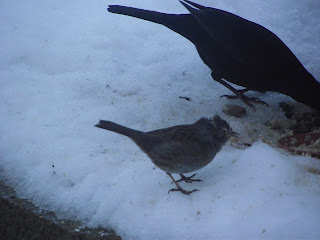Went to the supermarket (nearest eight miles) yesterday. Came out, loaded the shopping, got into the car and started to drive out of the car park when I saw something on the windscreen. Stopped, got out, had a look and discovered what I believe was a harliquin ladybird - black body with two red spots and white spots each side of the head. Guess what - no camera, no glasses, no magnifying glass, nothing to catch and carry it in - brilliant!!! For the eight miles drive home it stayed glued to the windscreen and I had visions of being able to get the camera and get the required image but when I stopped and parked the inevitable happened it 'legged it' or should I say 'winged it'!!!
However a few days ago I did manage two shots of a two spot ladybird. The first was in the garden privet hedge and from there it promptly decamped to the patio table and as I took the photo it vanished into thin air!!! Some you win - I was going to say some you lose but I am not so sure at the moment as I managed to get a couple of pics of a strange 'bird' crossing the garden this afternoon. It was preceded by five youngsters' but inevitably I was too slow to get my hands on my camera. As I said earlier some you win and .....
..
.
David's Wildlife Photography
A record of wildlife recorded in or near our wildlife garden.
Tuesday, 5 June 2012
Sunday, 29 April 2012
Lizards.
A few days ago I was moving trays of seedlings from a coldframe when my eye caught a movement but I did not see what caused it. I left the top of the frame open and shortly afterwards when I was passing I saw this lizard which apparently was trying to find a spot in the fitful sunshine. It gave a good impression of trying to hide but nothing compared to "I'm watching you watching me" in the next image.
In the ten years my wife and I have lived here we have seen colonies (I dont know if there is a collective noun) of lizards in the garden - they seem to particularly relish the limestone of this area.
These are some of the sightings over the years. The first image is apparently a pregnant female on top of a hebe shrub seeking the sunshine.
Lizards are known to shed their tails when in danger and I believe the next three images illustrate how they grow a replacement.
The last two images are juveniles.
They are fascinating creatures and provide endless enjoyment providing that they get what we all want - sunshine!!!
Thursday, 19 April 2012
Digger wasps?
My daily walk with 'the boss' takes me along a farm track which in dry weather becomes very compacted with the daily use of heavy tractors and farm machinery. I dont know how to describe the ground other than that with wet weather it becomes thick clinging mud only to dry to a rock hard surface when it dries out. Year in year out I find these small mounds and burrows in a particular length of the track. I have never been fortunate enough to see the occupants but researching the matter I think that they are digger wasps and possibly ammophila sabulosa or hinderius albilabris until somebody tells me otherwise!!! I found these particular burrows at the beginning of this month. Needless to say with the present heavy rain and tractor use they no longer exist and so I will have to wait for when (or if) the sunshine returns.
Wednesday, 18 April 2012
Sorry state of affairs.
Earlier today I went for my usual walk with 'the boss' - terrible weather with rain and wind. Sad to say I found the severed head of a young fallow stag. No photo. No further comment.
Deformities of Birds.
During the autumn and winter months my wife and I noticed a rather large number and variety of birds with various deformities and diseases but it proved impossible to get decent photographs. The magpie featured in my previous post is incapable of using it's legs - simply using it's breast to land and perch (it is still surviving today). The great tit was only seen once - it had a large growth on the side of it's face and seemed incapable of turning it's head. At least two dunnocks were seen with head deformities and soon vanished from the scene. Two partridges were seen - one had a large lump/growth to the rear of it's left eye partly obscuring it. The other one had some sort of deformity on top of it's head. Blackbirds also featured with top of the head baldness and some sort of scaley growth. Chaffinches were prominent with scaley leg growths and one I nick named 'helicopter' because it's legs seemed so painful that it had to hover to gently lower itself to the ground. Finally when the fieldfare appeared I did not give much for it's chances - it tucked itself away for a couple of days. Eventually we managed to coax it out to partake of apples. Over a period of five days it seemed to recover it's strength and flew away.
Tuesday, 17 April 2012
Bombylius major.
A few days ago on a very cold morning my wife found this bee fly lying in gravel in a torpid state but after a few minutes there was slight movement so we moved it into a sunny spot. Sometime later it had recovered and flew away.
Saturday, 7 April 2012
Subscribe to:
Posts (Atom)























